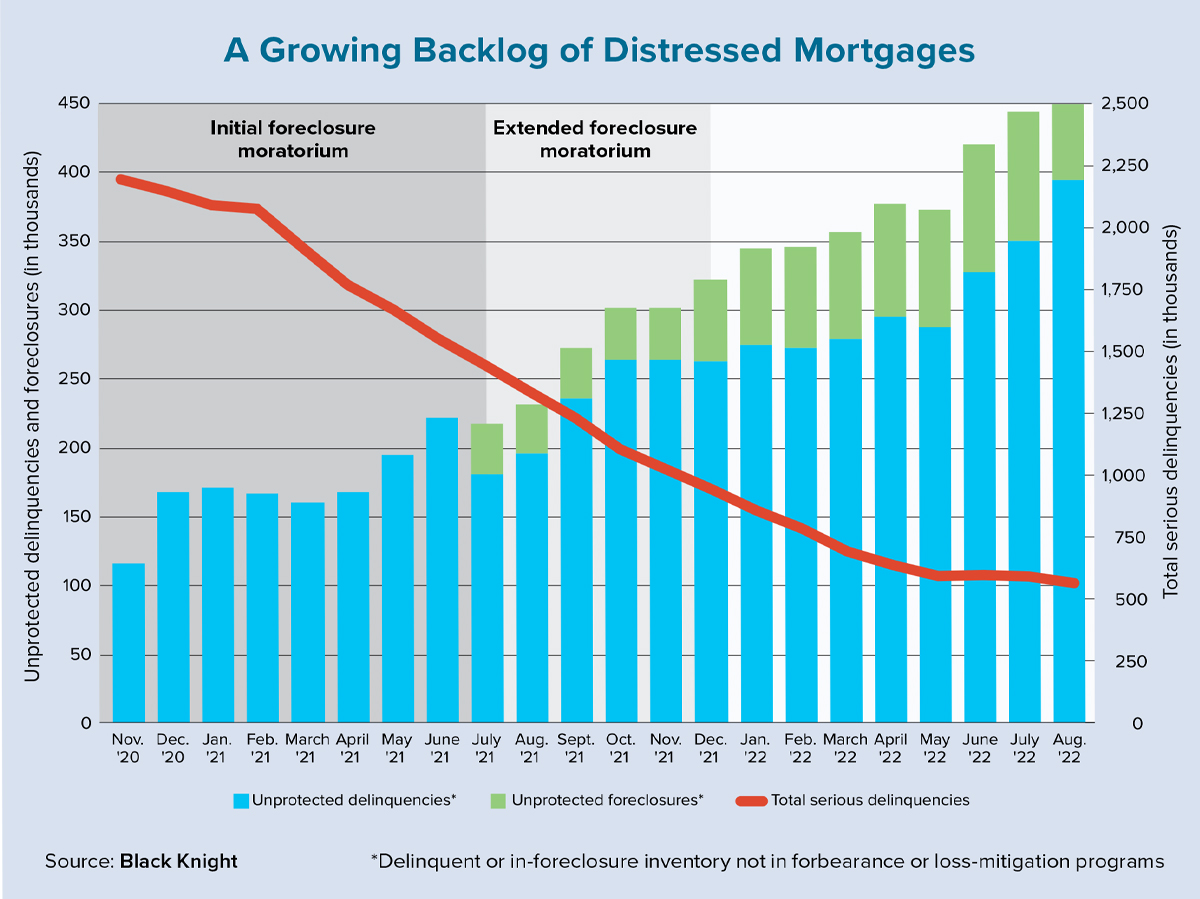Two converging trends could drive foreclosures in 2023. The first is a growing backlog of pandemic-era distressed properties that are no longer mitigated by foreclosure-protection laws, while the second is the growing risk of a housing and economic downturn that pushes more homeowners into distress.
The COVID-19 pandemic did not trigger a massive surge of foreclosures as some feared. This was due in large part to the widespread foreclosure protections put in place by policymakers and mortgage servicers soon after the health crisis was declared in March 2020.
An analysis of actual foreclosures compared to expected foreclosures based on historical roll rates from serious-delinquency status shows a deficit of 2.5 million fewer foreclosure starts than expected between second-quarter 2020 and second-quarter 2022. There were nearly 600,000 fewer completed foreclosures than expected during the same time frame. While pandemic protections were highly successful, there is still a small backlog of distressed properties that is gradually growing following the phaseout of foreclosure protections. This backlog represents one source of likely foreclosure volume in 2023.
As of August 2022, according to Black Knight,
488,000 mortgages were considered “unprotected,” meaning they were either delinquent or in foreclosure and not covered by forbearance or loss-mitigation programs. While total delinquencies continue to trend lower, this backlog of unprotected delinquencies is increasing, having grown by 44,000 (10%) from the previous month and by 256,000 (110%) from a year earlier. This growing stockpile represents past-due mortgages that have failed to or do not qualify for loss-mitigation efforts, making them more susceptible to foreclosure. Not all of these 488,000 homes will make it to foreclosure, of course. Many have enough equity to give the distressed homeowner the option to sell to avoid foreclosure.
Assuming a roll rate of 23% — based on the average roll rate expected by Auction.com clients in a June 2022 survey — these 488,000 distressed loans would translate to about 112,000 completed foreclosures, with most of them likely occurring in 2023. This would represent an increase from 2022, which is on track to see fewer than 100,000 completed foreclosures, according to an analysis of public record data from Attom Data Solutions. But it would still be about half of the 2019 level of 206,000 foreclosures, and only about 10% of the nearly 1 million foreclosures at the peak of the post-recession crisis in 2010.
The growing risk of an economic and housing downturn could add fuel to the foreclosure fire in 2023. Recessions typically result in job losses and a higher unemployment rate. Historically, this closely correlates with a rise in seriously delinquent mortgages and completed foreclosures. To back this assertion with numbers, if the U.S. unemployment rate rises to 6% in 2023 (instead of staying below 4% as it is now), an estimated 56,000 additional foreclosures would be completed next year. That’s a 32% increase from the 175,000 estimated foreclosure completions if jobless rates stay below 4% in 2023, according to a regression analysis produced by Auction.com.
A home price decline also would likely result in more foreclosures next year as the equity cushion would disappear for some distressed homeowners. Using the same regression model as above, a 1.5% decrease in U.S. home prices in 2023 —
which Fannie Mae predicted this past October — would equate to an additional 47,000 completed foreclosures in the coming year.
If the economy and housing market bend but don’t break, expect to see roughly 175,000 completed foreclosures in 2023. But this number could swell by nearly 60% to 278,000 if the country slips into recession and national home prices drop by 1.5% in the next year. ●
-
Daren Blomquist is vice president of market economics at Auction.com. In this role, Blomquist analyzes and forecasts complex macroeconomic and microeconomic data trends to provide value to both buyers and sellers using the platform. Blomquist has been cited by thousands of media outlets nationwide, including major news networks, The Wall Street Journal, The New York Times and USA Today. Prior to Auction.com, Blomquist worked at Attom Data Solutions.
View all posts





